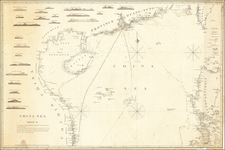The "Tamba Kosi-Likhu Khola" map, executed between 1960 and 1966, is drawn from the maps produced by the Survey of India, an organization with a rich history of topographical study. The fieldwork was carried out by Erwin Schneider, and the final map was drawn by Fritz Ebster.
This map covers the area between the Tamba Kosi and Likhu Khola rivers in the northeastern part of Nepal. The region's unique geographical features are meticulously captured in this detailed topographical rendering. It showcases the terrain's characteristics, such as elevation changes, steep slopes, river courses, and mountain passes, using accurate contour lines and gradient notations.
Fritz Ebster, the Austrian cartographer responsible for the actual map drawing, utilized clear line work and precise details to make the map easy to read. The map's layout and legend are straightforward, providing users with a simple yet comprehensive understanding of the terrain.
The Tamba Kosi-Likhu Khola region is nestled in the northeastern part of Nepal, representing a segment of the imposing Himalayan landscape. It encompasses the valleys of two rivers, Tamba Kosi, a prominent tributary of the Sun Kosi river, and Likhu Khola. The terrain in this area is challenging, featuring steep slopes, rugged passes, and riverine plains, providing a vivid display of the Himalayan topography.
The exploration history of the Tamba Kosi-Likhu Khola region can be traced back to the early part of the 20th century. Initially, exploration in this area was primarily driven by mountaineering expeditions seeking to conquer the numerous high peaks in the region. The geographical knowledge accumulated from these initial explorations laid the groundwork for more systematic surveys in the mid-20th century.
The Alpenvereinskartographie Innsbruck, also known as the Cartography Department of the Austrian Alpine Club in Innsbruck, is an esteemed organization with a rich history and pivotal role in creating detailed maps of alpine regions.
Founded in the late 19th century, the Austrian Alpine Club, Alpenverein, quickly recognized the need for precise maps to aid in the safe exploration and enjoyment of the Alps. This led to the creation of the Alpenvereinskartographie, a dedicated cartography department, located in Innsbruck, Austria.
Over the years, the Alpenvereinskartographie Innsbruck has produced numerous topographical maps, primarily focusing on the Alps but also including other significant mountainous regions worldwide. These maps are well-regarded for their accuracy, level of detail, and the practical use they offer climbers, mountaineers, hikers, and researchers.
In addition to serving the immediate needs of the mountaineering community, these maps are of significant historical and scientific value. They document the evolving landscapes due to climate change and human intervention and provide invaluable data for studies in geology, ecology, and climatology. The works of Fritz Ebster and Erwin Schneider, in particular, are excellent examples of the Alpenvereinskartographie's dedication to precise, comprehensive, and user-friendly mapping.











![[Shanghai to Nanjing] China Sheet IX Yang-Tse-Kiang From the Sea to Nanking Surveyed By Captns. C.R.D. Bethune H. Kellett & B Collinson, C.B. 1842.](https://storage.googleapis.com/raremaps/img/small/83103.jpg)

![[Ambon Island] Caart van het Eyland Amboina in 't bijsonder](https://storage.googleapis.com/raremaps/img/small/76744.jpg)
![[Tiruchirappalli] 1763 Plan de Trichenapaly](https://storage.googleapis.com/raremaps/img/small/58955.jpg)
![[Nepal to Myanmar and Eastern Thailand] Eastern Bengal, Assam, Burmah, and Parts of China and Siam 1870. With Additions and Corrections to 1875.](https://storage.googleapis.com/raremaps/img/small/76653.jpg)
![Il Disegno Della Terza Parte Dell' Asia [Gastaldi's Wall Map of SE Asia with extra panels!]](https://storage.googleapis.com/raremaps/img/small/30554hbp.jpg)